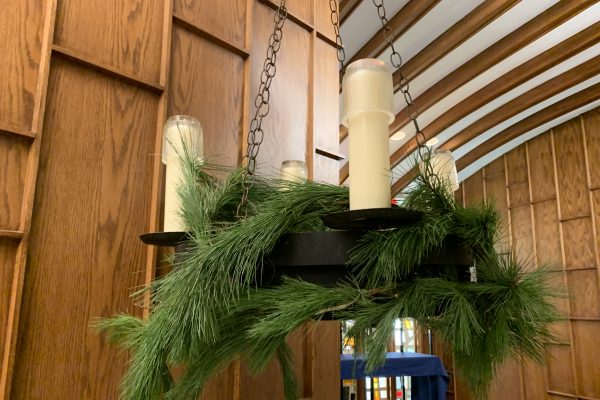Adventing in the Meantime

I’ve concluded that enterprising individuals can turn nearly anything into an advent calendar and sell it, so long as you can divide what you have to sell into 24 discrete pieces. Chocolate is the traditional choice, but now there’s beer or wine and even whiskey advent calendars. Sausage and cheese make for a December-long charcuterie board in 24 bite-size pieces. For the kids, there are small toys of all sorts hidden behind little cardboard doors to be assembled daily from those ubiquitous locking plastic bricks. If you want to encourage your young charge toward STEM fields, there’s even a set of 24 science projects that at the end of it all, yield a real working radio–for children who want to know what a radio is.
From the user’s perspective, the point of these advent calendars is the countdown to Christmas. The daily practice of finding the next numbered window, opening it to find the treat inside, and enjoying that treat brings the potential of both marking time toward the big day and slowing that time by inviting a small amount of enjoyment in anticipation of the big payoff. The calendar gets us through linear time from “A” to “B” or rather “1” to “24” in measured progress. There’s a beginning and an end and the date of the end is certain. It’s 24 chocolates from now.
The earliest advent wreaths had the same time-marking agenda. The story goes that the 19th-century German pastor and advocate for those living in poverty, Johann Hinrich Wichern, created the first advent wreath to help the children of his community manage their impatience as they waited for Christmas Day. Wichern’s wreath featured four large white candles to mark each of the four Sundays of Advent and added smaller red candles for each of the days of the week in between, offering the children a way to mark each day.
But the wreath’s shape — a circle — is significant in its own right.
Had Wichern simply been looking for a way to mark the days, a line (or rows) of candles would have done the trick. He would have started at the beginning and, in time, gotten to the predicted end.
The wreath tells a different story. Because, while the Advent season marks the days until Christmas, it is also a season of raised awareness of the promised return of Jesus Christ at the end of all time.
Nobody knows when that will be!
While each day brings us closer to that day, we don’t know how many little windows we’ll need for that advent calendar.
The same is true when we think about the day of our own certain death, our very own personal and profound “come to Jesus” moment.
The Bible teaches us to number our days as a path of wisdom, but none of us knows how big that number will end up being.
Wichern’s wreath with its circle that numbers the days but also turns back on itself without a clear beginning and end evokes the cyclical nature of time as it seeks to compel us to keep in mind what many of us already know: that our days seem to go on and on through a continuous cycle of “wanting” and “achieving” only be wanting and achieving all over again. The cycle seems to never end.
The temptation is to conclude that there’s nothing for us except this endless cycle, and that we might find satisfaction in an endless string of achievements.
Yet, we know that the days of achieving will come to an end, and if all we have is achievement, we will have nothing. Nothing but dust.
The Scripture readings appointed for the season of Advent offer us a way through (or out) of this endless cycle of days that will not be satisfied. Teachings of Jesus like those we find in Mark 13 with his predictions of solar and lunar eclipses and falling stars seem to set on scaring us to death, but Jesus’ wisdom is more creative than that. If it is true, as he says, that the most fundamental realities of our lives, like the shining of the sun, are subject to destruction, then what is left for us?
Just the eternal love of God.
It is a love that is not simply an idea but a commitment to your own, individual life.
Love is what is eternal. The love of God for the you that is you.
And that brings us to the second bit of wisdom in the shape of Wichern’s advent wreath. The simple circle is an eternity of shape and it is your crown.
Peace be with you,
– Pr. Jim
Nov. 29, 2023
Rev. Katherine Museus and Rev. James A. Wetzstein serve as university pastors at the Chapel of the Resurrection at Valparaiso University and take turns writing weekly devotions.
- James Wetzstein
- “Light” and Other “L” Words
- Keeping Up with the Holy Spirit
- It’s a Three Day Weekend!
- Divine Love Can’t Quit You
- I Had a Bit of a Moment
- What to do When Our Resolutions Don’t Deliver
- Have Yourself a Merry Little Christmas (Somehow)
- Adventing in the Meantime
- Life and Death Collisions
- Imagining Eternity
- Where is God for You?
- All You Need Is Love, Love Is All You Need
- God Uses Crooked Sticks to Draw Straight Lines
- “Reset/Refresh” Sabbath as rest, not distraction
- At least we’re all friends again
- Blessed are you peacemakers
- Forgiveness: the necessary miracle
- How to Recover from an Epic Failure
- In Praise of Skeptical Disciples
- It’s a Matter of Trust
- Light Shows Up
- Looking Forward!
- Mercy makes us uncomfortable
- Of fear and failure
- Open up!
- Standing with (New Year’s) Resolution
- The Touch
- To God be the glory
- We are always on the way